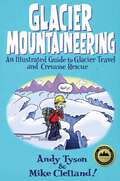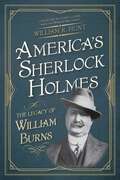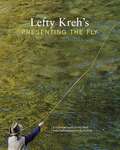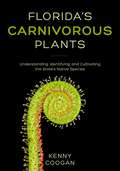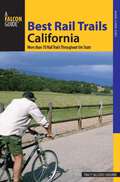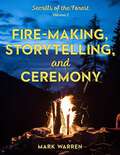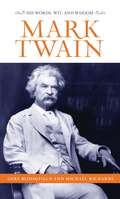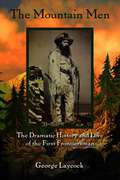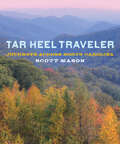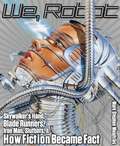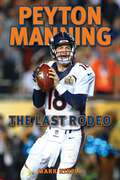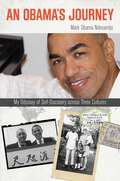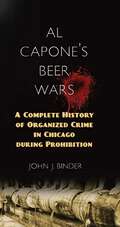- Table View
- List View
Glacier Mountaineering: An Illustrated Guide to Glacier Travel and Crevasse Rescue (How To Climb Series)
by Andy TysonGlacier Mountaineering provides the knowledge and skills needed to safely and self-sufficiently navigate over glacier terrain. Hundreds of hilarious and helpful illustrations by Mike Clelland complement the clear and concise text by Andy Tyson. Providing critical instruction for anyone planning to travel over glacier country—from the Cascades to the Rockies to Denali—this book will guide and entertain readers through glacier anatomy, equipment, route finding, and rescue techniques.
Lighthouses of New England: From Maine to Long Island Sound
by Ray JonesNew England's lighthouses project more than lifesaving beams across treacherous expanses of water. They also project an aura of steadfastness, dependability, and safety--and deservedly so. This guide features descriptions and beautiful photographs of more than sixty lighthouses from Northern Maine to the Long Island Sound.
Crochet Baby Blankets: 13 Easy to Intermediate Designs
by Kristi SimpsonWelcome baby with a beautiful handmade blanket!A crocheted blanket is the perfect gift for a new baby. Putting the time and effort into making your gift bestows a special meaning to it, and favorite blankets are often cherished into toddlerhood and beyond. Many become heirlooms for the next generation. The 13 designs in this book showcase a variety of stitches and techniques, but all are appropriate for a beginner to intermediate skill level. Crochet them in the color palettes shown, or use colors to match the nursery or your own favorite combinations. You'll delight in seeing the stitches fly off your hook as your blanket progresses, and baby and new mom will love snuggle time in the soft, beautiful afghan you made!
Foraging Mushrooms Washington: Finding, Identifying, and Preparing Edible Wild Mushrooms (Foraging Series)
by Jim MeuninckDetailed descriptions of edible mushrooms; tips on finding, preparing, and using mushrooms; a glossary of botanical terms; color photos. Use Foraging Mushrooms Washington as a field guide or as a delightful armchair read. No matter what you&’re looking for, be it the curative Heal-All or a snack, this guide will enhance your next backpacking trip or easy stroll around the garden, and may just provide some new favorites for your dinner table.
Scats and Tracks of the Mid-Atlantic: A Field Guide To The Signs Of Seventy Wildlife Species (Scats and Tracks Series)
by James Halfpenny Jim BruchacSee those animal signs on the trail? Was that footprint left by a fox or a wolf? Was that pile of droppings deposited by a moose, a mouse, or a marten? Scats and Tracks of the Mid-Atlantic will help you determine which mammals, birds, reptiles, and amphibians have passed your way and could still be nearby. Clearly written descriptions and illustrations of scats, tracks, and gait patterns will help you recognize species across Pennsylvania, Delaware, Maryland, Virginia, West Virginia, and North Carolina. An identification key, a glossary of tracking terms, and detailed instructions on how to document your finds are also included here. Easy-to-use scat and track measurements appear on each page, making this book especially field friendly and letting you know if a white tailed ptarmigan, a red fox, or even a black bear has been your way.
Baltimore Chef's Table: Extraordinary Recipes from Charm City and the Surrounding Counties (Chef's Table)
by Neal Patterson Kathryn Wielech PattersonIn the midst of recent growth and downtown development, Baltimore is breaking away from its culinary stereotypes and emerging as city that is attracting some extraordinary restaurants and talented chefs. While embracing the local food movement, the city is now being recognized for an expanding culinary movement. Newcomers and homegrown chefs alike are charming diners with delicious variations staring the perennial favorite, crab, as well as offering unique options like frankenfish tacos and hearts of palm crab cakes that are becoming the taste of Charm City.With more than eighty recipes for the home cook from over fifty of the city's most celebrated eateries and showcasing photos featuring mouth-watering dishes, famous chefs, and lots of local flavor, Baltimore Chef's Table is the ultimate gift and keepsake cookbook for both tourists and locals alike.
Best Trail Runs San Francisco
by Nancy Hobbs Adam W. ChaseBest Trail Runs San Francisco features nearly forty of the best trail runs within an hour or so of downtown—complete with color photos, maps, and detailed specs and trail descriptions. Full of inspirational photos throughout, this book includes practical maps, elevation gains, and key information on training, safety, and must-see attractions along the way.
America's Sherlock Holmes: The Legacy of William Burns
by William R. HuntWilliam Burns is best known as &‘America&’s Sherlock Holmes&’ and became director at the Bureau of Investigation, to be immediately followed by J. Edgar Hoover. But before he became director, Burns had a long, highly publicized career as a government detective for the Secret Service, then as the head of the famed Burns International Detective Agency, which he founded after leaving government service. These successes encouraged Burns to start his own agency and he successfully competed with his hated rival, the Pinkerton Detective Agency. He was a public hero for many years (except among labor union men who remembered his questionable tactics in the notorious McNamara case involving the bombing of the Los Angeles Times). But to the general populace, he was a white knight protecting the public interest until he disgraced his government office.
Lefty Kreh's Presenting the Fly: A Practical Guide To The Most Important Element Of Fly Fishing
by Lefty KrehLefty Kreh&’s Presenting the Flydetails the most essential analysis in fly-fishing: how to get the right fly to the right fish, in the right way, at the right time. This vastly comprehensive, large-format volume explains the ways that shape, color, and weight of the fly can determine success under varying conditions.
Scats and Tracks of Alaska Including the Yukon and British Columbia: A Field Guide To The Signs Of Sixty-Nine Wildlife Species (Scats and Tracks Series)
by James HalfpennySee those animal signs on the trail? Was that footprint left by a fox or a wolf? Was that pile of droppings deposited by a moose, a mouse, or a marten? Scats and Tracks of Alaska Including the Yukon and British Columbia will help you determine which mammals, birds, reptiles, and amphibians have passed your way and could still be nearby. Clearly written descriptions and illustrations of scats, tracks, and gait patterns will help you recognize species across the entire region. An identification key, a glossary of tracking terms, and detailed instructions on how to document your finds are also included here. Easy-to-use scat and track measurements appear on each page, making this book especially field friendly and letting you know if a white tailed ptarmigan, a red fox, or even a black bear has been your way.
Florida's Carnivorous Plants: Understanding, Identifying, and Cultivating the State's Native Species
by Kenny CooganLearn about Florida's endemic carnivorous plants in this exciting book written for the budding naturalist and hobbyist. Florida has dozens of native species of carnivorous plants––more than any other state in the United States—including sundews, butterworts, bladderworts, and pitcher plants. These plants use appealing scents, leaves, and sticky fluids to trap and imprison insects. Digestive fluids then absorb the prey giving the plant its nutrients. Many of these plants can be grown at home in the backyard, in rain gardens, or in some cases on the windowsill. Florida&’s Carnivorous Plants provides an identification and growing guide for the major genera of carnivorous plants found in Florida. Each species description includes etymology, a history of the plant&’s discovery highlighting diverse scientists, anatomy, habitat range, and popular cultivars for beginners. Tables include soil requirements, types of potting, water level, amount of light, dormancy and temperature requirements, and propagation tips. A glossary provides readers with the tools to learn botanical jargon to improve their identification skills.
Best Rail Trails California: More Than 70 Rail Trails Throughout the State (Best Rail Trails Series)
by Tracy SalcedoComprehensive directory to the state's most popular rail trails. Each trail will receive a full trail profile, descriptive narrative, detailed information, and more.
Fire-Making, Storytelling, and Ceremony: Secrets of the Forest
by Mark WarrenIn the second volume of the Secrets of the Forest series, Mark Warren addresses a wide range of what an outdoorsperson needs to know about fire such as:how to create it from scratch using three different methods (hand drill, bow drill, and fire-saw).which species of trees and dried winter weeds make good candidates for a fire kit.where to find tinder that can combust.how to construct a fail-proof pyre by mixing fast-burning fuel with dense hardwood.how to sustain a fire for the long term, including how to safely store a smoldering fire that can survive for several days.The second half of the book is dedicated to storytelling and ceremony. Its main purpose is how to design stories that augment whatever lessons a teacher has in mind. Such stories can familiarize students with the fine points of archery, canoeing, tracking, stalking, and other crafts or skills. Borrowing from Native American traditions, Warren introduces dozens of ways for young outdoorspeople to build self-esteem and a deep connection with the forest. This volume contains more than 100 original activities.
Mark Twain: His Words, Wit, and Wisdom
by Michael Richards Gary L. BloomfieldA unique collection of quotes and photos revealing a new side of Mark Twain's humor and wit.A highly entertaining collection of timeless quotations from Mark Twain. The 19th-centurey American writer, humorist, public speaker, and publisher wrote hundreds of short stories, and his best-known novels include The Adventures of Tom Sawyer and Adventures of Huckleberry Finn, still read more than 130 years later. Born with the visit of Halley&’s Comet in 1835, he died when the comet returned to the solar system in 1910. He remains one of the most quoted – and quotable – American writers of all time. It includes more than 100 glorious images of this most famous son of Hannibal, Missouri.
Armies South, Armies North
by Alan AxelrodAn argument settler--and starter--for Civil War buffs who want to know which side had the better soldiers: Armies South, Armies North definitively compares the military forces of both sides. Civil War buffs are always arguing over which side had the better soldiers. Armies South/Armies North by Alan Axelrod helps readers reconsider their understanding of America&’s most harrowing war. Axelrod is the author of more than one hundred books with a passion for military history and leadership. Each chapter of his new book compares the military forces with both quantitative and qualitative measures. Axelrod analyzes the equipment, the leadership and strategies, and the men who fought in each army, with additional focus on lesser known flash points during the war.
The Orvis Guide to Muskies on the Fly
by Kip ViethThe essential Orvis primer on fly-fishing for Muskies, addressing every requirement of the sport and providing an excellent foundation for years of pleasurable fishing. It includes instructions for tackle selection; casting and presentation; flies; essential knots and how to tie them; successful techniques on rivers and lakes; and much more. Muskies are BIG and DANGEROUS fish, and the Orvis Guide shows you how to land these challenging monsters.
The Mountain Men: The Dramatic History And Lore Of The First Frontiersmen
by George LaycockTo know how the West was really won, start with the exploits of these unsung mountain men who, like the legendary Jeremiah Johnson, were real buckskin survivalists. Preceded only by Lewis and Clark, beaver fur trappers roamed the river valleys and mountain ranges of the West, living on fish and game, fighting or trading with the Native Americans, and forever heading toward the untamed wilderness.In this story of rough, heroic men and their worlds, Laycock weaves historical facts and practical instruction with profiles of individual trappers, including harrowing escapes, feats of supreme courage and endurance, and sometimes violent encounters with grizzly bears and Native Americans.
Tar Heel Traveler: Journeys across North Carolina
by Scott MasonA blend of oral history and memoir with a good dose of quirky humor, the Tar Heel Traveler is a celebratory look at the people and places of North Carolina. Mason is the TV reporter—the Tar Heel Traveler—who journeys across North Carolina profiling colorful characters and out-of-the-way places.
We, Robot: Skywalker's Hand, Blade Runners, Iron Man, Slutbots, and How Fiction Became Fact
by Mark MeadowsWe, Robot does for robotics what Michio Kaku&’s bestselling Physics of the Impossible has done for physics. How close to becoming reality are our favorite science fiction robots? And what might be the real-life consequences of their existence? Robotics and artificial intelligence expert (and science fiction fan) Mark Stephen Meadows answers that question with an irresistible blend of hard science, futurist imagination, solid statistics, pop culture, and plenty of humor.
Peyton Manning: The Last Rodeo
by Mark KiszlaPeyton Manning is America&’s quarterback. And America loves a great comeback story. Less than two years after Manning was fired from the Indianapolis Colts, he led the Denver Broncos to the Super Bowl and won pro football&’s Most Valuable Player award for the fifth time. In 2013, Manning broke the league record for touchdown passes in a single season, despite a body weakened by multiple neck surgeries that threatened to end his career. Manning did it against all odds, in a manner inspirational to any football fan—or anybody who has ever lost a job and been forced to start over.Peyton Manning: The Last Rodeo follows Manning&’s remarkable season with the Broncos on a wild ride to the championship game. Through it all, from the suspension of a star teammate to the heart ailment of his head coach, Manning carried the Broncos and reminded us why he is one of America&’s most beloved role models.
An Obama's Journey: My Odyssey of Self-Discovery across Three Cultures
by Mark Obama NdesandjoIn this revealing and beautifully written memoir, Mark Obama Ndesandjo, recounts his complex relationship with his older half-brother, President Barack Obama, including their first meeting in Kenya over twenty years ago. The book also offers the author's inspiring personal story about identity and multiculturalism. Rare family photos add to the book's personal nature as does the intense recounting of domestic violence in the home of Barack Obama Sr.’s and his third wife, Ruth Baker, Mark’s Jewish-American mother. The book also attempts to set the records straight on several points of the president’s best-selling memoir Dreams from My Father. In its connection to President Obama, Mark's story takes on an even greater significance because it becomes all the more directly, a story of American identity and a window into the complex figure of the father they share, Barack Obama Sr., their roots in Kenya, their multicultural identities, and their relationships with America.
Al Capone's Beer Wars: A Complete History of Organized Crime in Chicago during Prohibition
by John J. BinderAlthough much has been written about Al Capone, there has not been--until now--a complete history of organized crime in Chicago during Prohibition. This exhaustively researched book covers the entire period from 1920 to 1933. Author John J. Binder, a recognized authority on the history of organized crime in Chicago, discusses all the important bootlegging gangs in the city and the suburbs and also examines the other major rackets, such as prostitution, gambling, labor and business racketeering, and narcotics. A major focus is how the Capone gang -- one of twelve major bootlegging mobs in Chicago at the start of Prohibition--gained a virtual monopoly over organized crime in northern Illinois and beyond. Binder also describes the fight by federal and local authorities, as well as citizens' groups, against organized crime. In the process, he refutes numerous myths and misconceptions related to the Capone gang, other criminal groups, the St. Valentine's Day Massacre, and gangland killings. What emerges is a big picture of how Chicago's underworld evolved during this period. This broad perspective goes well beyond Capone and specific acts of violence and brings to light what was happening elsewhere in Chicagoland and after Capone went to jail. Based on 25 years of research and using many previously unexplored sources, this fascinating account of a bloody and colorful era in Chicago history will become the definitive work on the subject.
Cowboy Values: Recapturing What America Once Stood For
by James P. OwenJim Owen leads a massively successful seminar that is in huge demand by financial groups, teachers&’ organizations, and professional associations. Here Owen continues his nonpartisan message, offering the legacy of the cowboy as a model of accessible, positive qualities that all can agree on, regardless of religion or political persuasion.
Standup Paddling Montana: A Guide to the Best Rivers, Lakes, and National Parks in the Region (Paddling Series)
by Greg PetersAnchored by two stunning national parks, carved by dozens of rivers and sprinkled with glistening lakes, Montana is a standup paddling paradise. From calm paddles set against snowcapped mountains to whitewater routes for adventurous souls, Standup Paddling Montana features thebest sites across the state for standup paddlers of all skill levels.
America's Best Brews: The Definitive Guide to More Than 375 Craft Beers from Coast to Coast
by Steve JohnsonThis book describes and rates more than 375 of the best craft beers, identifies who actually makes them, explains how beer is made, guides you in homebrewing, lists beer festivals, and reveals America's top 25 breweries.
